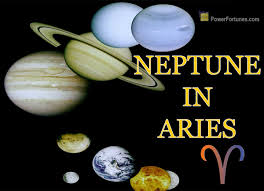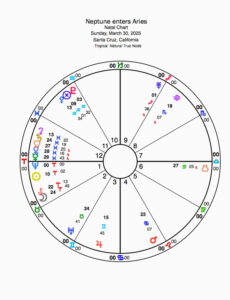NIGHT LIGHT NEWS
DAILY POSTINGS
Sunday, March 30, 2025- 9am
Neptune’s Journey!
A class (in depth history then & now) on the blue planet Neptune We are in school today –
Today – Sunday, March 30, 2025, is a pivotal point of change for humanity.
As a major generational planet, Neptune, ended at 164 year cycle & began a new 164-year cycle.
As Neptune has entered Aries, a new cycle of life & livingness, a new reality & focus begins.
A most important question for everyone.
Consulting our astrology charts.
Where is 0 Aries in everyone’s chart?
That is where Neptune is in our lives.
What area of life if it for you? What house?
In this way the astrology posted here become relevant, alive, & real in our lives. This is the application of astrology. This is how astrology becomes useful for each of us.
And so….
Neptune entered Aries early this morning – a new cycle of life & livingness begins for humanity. A new sense of identity, values, communication, creativity, relationships, journeys, world progress, world culture & civilization, religion & spirituality.
And so…
Shifting into a new sign every 14 years…it’s been 164 years since Neptune was in Aries.
And so….
At 5am (PT) this morning, Neptune completed a 164-year cycle around the Sun
And entered the sign of Aries.
From Aries (1861 – 1875, US Revolution, slavery abolished, women’s suffragette), thru all the signs to Pisces (yesterday Neptune was at 29.59 Pisces & there was a feeling of something new & big was going to occur!) until this morning Neptune brought in a new cycle of life & livingness, spirituality & bold new realities.
From Dreams to Fire
Neptune left the hazy blue mystical dream state of Neptune & entered into the initiating (all things new), red & fiery, intensely powerful sign of Aries (once again!) early this morning.
Angels
Aries is the rebel. Neptune is the Angel. What is a rebellious angel like? Oh, we remember! It was the rebellious angels who told God He needed to let Adam & Even have a sense of mentation, a brain mind It was the rebellious angels who wanted the first humans to eat of the Tree of Knowledge so they could have freedom.
Neptune in Aries – the spiritual warrior!
Neptune is Ray 6 – desires, aspirations, hopes, wishes, dreams, visions, religion (skillful virtues).
Unskillful (we see this in our country today) – rage, anger, destruction, fomentation of confusion, lies, illusions, glamours, extreme rebelliousness, fanaticism, refusal to move forward into new realms that help humanity thrive, blindness.
Neptune – the ruler of the Age of Pisces.
With Neptune leaving Pisces & entering the “all things news” of Aries, which initiates new realities, it is safe to say we are well on our Way to our Sun entering & atmosphere & architecture of the Age of Aquarius. And thus we are too!
Neptune’s Realms – Hollywood!
Neptune creates what feels like a magical realm.
The epitome of Neptune is Hollywood.
the film industry provides images in the collective psyche, part of a mass participation in creating thought forms–which then take on more solid substance. Filmmaker and audience dance together and literally create many of the energies which permeate society.
A study of Neptune’s transits, Hollywood & the film industry would reveal Hollywood’s history & the evolution of both film & stories. Movies were invented when Neptune was in Gemini (Mercury ruled). The first camera was patented June 21, 1889. The first film, in collaboration with Thomas Edison, was made in May, 1881. If we follow Neptune’s transits thru the signs, we will see a reflection of the types of stores & films that were the vogue at every fourteen years.
Generational Planet
(note: “Generational” signifies a connection to a group of people who are roughly the same age and have experienced similar historical events and cultural trends. Time span – 15- 20/30 years. Child born to growing up to age 20/30.)
Neptune is called the “generational planet.”
Neptune will be in Aries until 2039. Neptune drifted slowly thru Pisces (spirituality), its home sign, since 2011. Now it will take a wild ride into Aries – a watery sensitive ethereal planet of blue into the realm of passion, impulse and pioneering red fires of Aries.
Neptune in Aries – What may happen?
The waters of Neptune can be determined to overwhelm & drown oppressive structures that have held humanity back for eons of time.
With Neptune in Aries, our determination, our intentions & aspirations will become clearer. There will be a spirituality that accompanies our lives, a refinement, too. Neptune “refines” Aries, which is the innovator – thus refined new innovations will appear. That which is old & useless will dissolve away (quite like the solar eclipse we had yesterday). Transcendence will be a call we hear & nothing will stand in its way. Our way of life will gradually be reshaped.
The strongest indication of Neptune is our intuition, which will be more pronounced in all the signs – from Aries to Pisces.
History of Neptune’s Discovery
First observed by Galileo in 1612, but disregarded as a fixed star. Then mathematically “discovered” again by scientists at the Berlin Observatory, Neptune was on the border of Aquarius (1-degree NE of Aquarii) & Capricorn. Neptune’s discovery was confirmed during a groundbreaking Neptune-Saturn conjunction in Aquarius.
179 Years Ago: Astronomers Discover Neptune, the Eighth Planet orbiting the Sun. (Uranus was accidently discovered in 1781 at the New Berlin Observatory).
However, (see below), Galileo saw the planet Neptune first, in 1612, thinking this pale blue object in the sky was a fixed star.***
As astronomers continued to observe the newly discovered planet, they noticed irregularities in its orbit that Newton’s law of universal gravitation could not fully explain. However, effects from the gravity of a more distant planet could explain these perturbances.
By 1845, Uranus had completed nearly one full revolution around the Sun and astronomers Urbain Jean-Joseph Le Verrier in Paris and John Couch Adams in Cambridge, England, independently calculated the location of this postulated planet. Based on Le Verrier’s calculations, on the night of Sept. 23-24, 1846, astronomer Johann Gottfried Galle used the Fraunhofer telescope at the Berlin Observatory and made the first observations of the new planet, only 1 degree from its calculated position.
In retrospect, following its formal discovery, it turned out that several astronomers, starting with Galileo Galilei in 1612, had observed Neptune too, but because of its slow motion relative to the background stars. did not recognize it as a planet.
The discovery was made using a telescope since Neptune is too faint to be visible to the naked eye, owing to its great distance from the Sun. Astronomers soon discovered a moon orbiting Neptune, but it took more than a century to discover a second one. Our knowledge of distant Neptune greatly increased from the scientific observations made during Voyager 2’s flyby in 1989, including the discovery of five additional moons and confirmation of dark rings orbiting the planet.
On the night of Sept. 23-24, 1846, astronomers discovered Neptune, the eighth planet orbiting around the Sun. It was a mathematical discovery.
Astronomers noticed that Uranus’s orbit didn’t quite match the predictions based on the gravitational influence of known planets like Jupiter and Saturn. John Couch Adams (using Bode’s Law), along with Urbain Le Verrier, independently predicted Neptune’s existence and location by analyzing discrepancies in Uranus’s orbit, using mathematical calculations to deduce the presence of an unseen planet causing those deviations.
*** Galileo’s drawings show that he observed Neptune (it had just begun to retrograde) on December 28, 1612, and again on January 27, 1613;[8] on both occasions, Galileo mistook Neptune for a fixed star when it appeared very close (in conjunction) to Jupiter in the night sky.
Historically it was thought that he believed it to be a fixed blue star, and so he is not credited with its discovery. At the time of his first observation in December 1612, it was stationary in the sky because it had just turned retrograde that very day; because it was only beginning its yearly retrograde cycle, Neptune’s motion was thought to be too slight, and its apparent size too small, to clearly appear to be a planet in Galileo’s small telescope.
However, in July 2009, University of Melbourne physicist David Jamieson announced new evidence suggesting that Galileo was indeed aware that he had discovered something unusual about this “star”.
Galileo, in one of his notebooks, noted the movement of a background star (Neptune) on January 28 and a dot (in Neptune’s position) drawn in a different ink suggests that he found it on an earlier sketch, drawn on the night of January 6, suggesting a systematic search among his earlier observations. However, so far there is neither clear evidence that he identified this moving object as a planet, nor that he published these observations of it. There is no evidence that he ever attempted to observe it again.
Galileo Galilei observed Neptune twice, once on December 28, 1612, and again on January 27, 1613.
When Galileo observed Neptune in 1612 and 1613, mistaking it for a fixed star, Neptune was in the sign of Gemini – the communicator, Mercury. Gemini – Ray 2 of Love/Wisdom.


